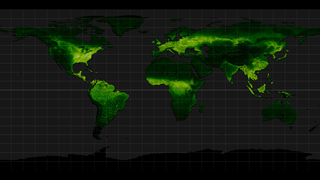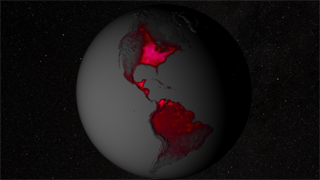Fluorescence Visualizations in High-Resolution (Comparison to NDVI)
The new maps, released in 2013, provide a 16-fold increase in spatial resolution and a 3-fold increase in temporal resolution over the first proof-of-concept maps released in 2011. This lets scientists use fluorescence to observe, for example, variation in the length of the growing season.
These visualizations of the phenomenon shows global land plant fluorescence data collected from 2007 to 2011, combined to depict a single average year. Darker greens indicates regions with little or no fluorescence; lighter greens and white indicate regions of high fluorescence.
Fluorescence and Normalized Difference Vegetation Index (NDVI) are compared. A visualization is provided comparing the northern hemisphere of both data sets. Individual visualizations are also provided in a standard cylindrical equidistant projection for wrapping to a globe. The same color bars are used for both data sets for easier comparison.


Related
Visualization Credits
Kayvon Sharghi (USRA): Producer
Joanna Joiner (NASA/GSFC): Scientist
Kathryn Hansen (Wyle Information Systems): Writer
NASA's Goddard Space Flight Center Scientific Visualization Studio
https://svs.gsfc.nasa.gov/4100
Data Used:
MetOp/GOME-2/GOME-2 Solar Induced Fluorescence at 740 nm
Observed Data - ESAThis item is part of this series:
Science On a Sphere
Keywords:
SVS >> HDTV
SVS >> Hyperwall
SVS >> Fluorescent Light
NASA Science >> Earth













